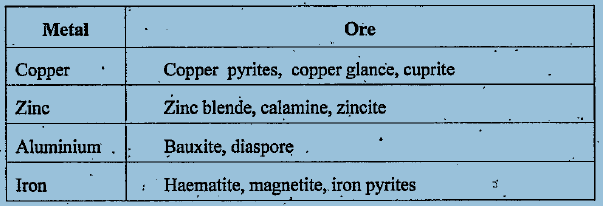The passage of current liberates H2, at cathode and Cl2 at anode. The solution is : Copper chloride in H2O, NaCl in H2O, H2SO4, waterSolution in Malayalam
Copper chloride in H_2 O
NaCl in H_2 O
H_2 SO_4
water
The correct Answer is:B
Step by step video, text & image solution for The passage of current liberates H_2, at cathode and Cl_2 at anode. The solution is : Copper chloride in H_2 O, NaCl in H_2 O, H_2 SO_4, water by Chemistry experts to help you in doubts & scoring excellent marks in Class 12 exams.
Updated on:21/07/2023Topper's Solved these Questions
Similar Questions
Write the formulas for the following coordination compounds: i) Tetraamminediaquacobalt(III) chioride ii) Potassium tetracyanonickelate(II) iii) Tris(ethane-1,2-diamine)' chromium(III) chioride s iv) Ámminebromidochloridonitrito-N-platinațe(II) v) Dichloridóbis(ethane-l,2-diamine) platinum (iv) nitrate vi) Iron(III) hexacyanoferrate (II)
View SolutionAnalyses the table given below:
 Which of the ores mentioned in the above table can be concentrated by magnetic separation method? Justify your answer.
Which of the ores mentioned in the above table can be concentrated by magnetic separation method? Justify your answer.
View SolutionIn the following reaction, H2SO4 acts as
HCOOHH2SO4−−−→CO+H2O.
View SolutionIn the following reaction, H2SO4 acts as
2Ag+H2SO5→Ag2SO4+2H2O+SO2.
View SolutionThe passage of current through a solution of certain electrolyte results in the evolution of H2(g) at cathode and Cl2(g) at anode. The electrolytic solution is :
View SolutionThe passage of current liberates H_2 at cathode and Cl_2 at anode. The solution is
View SolutionIn the reaction HCOOH overset(H_2 SO_4) to CO + H_2 O, H_2 SO_4 acts as
View SolutionIn the reaction 2Ag + 2 H_2 SO_4 to Ag_2 SO_4 + 2 H_2 O + SO_2, H_2 SO_4 acts as
View SolutionComplete the reaction of benzene diazonium chloride with : (i) H_2 O //H_2 SO_4 (ii) CuBr//HBr .
View SolutionThe passage of current through a solution of certain electrolyte results in the evolution of H2(g) at cathode and Cl2(g) at anode. The electrolytic solution is :
View SolutionExplain why electrolysis of aqueous solution of NaCl gives H2 at cathode and Cl2 at anode.
View SolutionThe electrolysis of a solution resulted in the formation of H2 at the cathode and Cl2 at the anode. The liquid is :
View SolutionThe electrolysis of a solution resulted in the formation of H_2 at the cathode and Cl_2 at the anode. The liquid is :
View SolutionThe passage of current through the solution of a certain electrolyte results in the liberation of H_2 at the cathode and Cl_2 gas at anode. The solution in the container could not be
View SolutionIn the following reaction, H2SO4 acts as
HCOOHH2SO4−−−→CO+H2O.
View Solution
